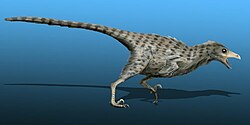Mahakala omnogovae
| Mahakala Temporal range: Late Cretaceous
| |
|---|---|

| |
| Reconstruction of Mahakala omnogovae | |
| Scientific classification | |
| Kingdom: | |
| Phylum: | |
| Class: | |
| Superorder: | |
| Order: | |
| Suborder: | |
| Family: | |
| Genus: | Mahakala Turner et al., 2007
|
| Species | |
| |
Mahakala (from Sanskrit, named for Mahakala, one of eight protector deities (dharmapalas) in Tibetan Buddhism) is a genus of basal dromaeosaurid dinosaur from the Campanian-age (about 80 million years ago) Upper Cretaceous Djadokhta Formation of Ömnögov, Mongolia. It is based on a partial skeleton found in the Gobi Desert. Mahakala was a small dromaeosaurid (approximately 70 centimeters long (28 in)), and its skeleton shows features that are also found in early troodontids and avialans. Despite its late appearance, it is among the most basal dromaeosaurids. Its small size, and the small size of other basal deinonychosaurians, suggests that small size appeared before flight capability in birds.
Description
Mahakala is based on IGM 100/1033, a partial skeleton including skull bones, vertebrae, limb bones, and portions of the pelvis and shoulder girdle. Although this individual was small, comparable in size to Archaeopteryx, Caudipteryx, and Mei, it was close to adulthood. This genus can be distinguished from other paravians (dromaeosaurids, troodontids, and birds) by details of the ulna, thighbone, ilium, and tail vertebrae. Like Archaeopteryx and derived dromaeosaurids, but unlike basal troodontids and other dromaeosaurids, the middle (third) metatarsal was not compressed, suggesting that the uncompressed version was the basal version. It had a typical dromaeosaurid form of the second toe, with an expanded claw.[1]
Classification
A phylogenetic analysis performed by Turner and colleagues, who described the specimen, found Mahakala to be the most basal known dromaeosaurid. Their results, along with the small size of other theropods found at the base of paravian lineages, suggest that small size was not an innovation of early birds, but a common trait of early paravians; small size would have preceded flight and would not have been a special avian autapomorphy as the result of a size squeeze. Like birds, troodontids and dromaeosaurids did not retain small size throughout their evolutionary history, and had several separate size increases among different lineages. Mahakala also shows a combination of characteristics found among basal troodontids and birds, and is missing some that are present in more derived dromaeosaurids.[1]
Paleoecology and paleobiology
The paleoenvironment of the Djadokhta Formation is interpreted as having a semiarid climate, with sand dune and alluvial settings. The semiarid steppe landscape was drained by intermittent streams and was sometimes affected by dust and sandstorms, and moisture was seasonal. Animals present included terrestrial turtles and crocodilians, lizards, mammals, and a variety of dinosaurs; aquatic animals like fish were not present. The majority of the fauna was small to medium-sized.[2] Small coelurosaurians are the most diverse dinosaurs, including fellow dromaeosaurid Velociraptor, troodontids Byronosaurus and Saurornithoides, oviraptorids Citipati, Khaan, and Oviraptor, and alvarezsaurs Mononykus and Shuvuuia; other dinosaurs present included ceratopsian Protoceratops and ankylosaurid Pinacosaurus.[3] Like other dromaeosaurids, Mahakala would have been a small active predaceous carnivore.[4]
References
- ^ a b Turner, Alan H. (2007). "A basal dromaeosaurid and size evolution preceding avian flight" (pdf). Science. 317: 1378–1381. doi:10.1126/science.1144066.
{{cite journal}}: Unknown parameter|coauthors=ignored (|author=suggested) (help) - ^ Jerzykiewicz, Tom (1997). "Djadokhta Formation". Encyclopedia of Dinosaurs. San Diego: Academic Press. pp. 188–191. ISBN 0-12-226810-5.
{{cite book}}: Unknown parameter|editors=ignored (|editor=suggested) (help) - ^ Weishampel, David B. (2004). "Dinosaur distribution". In Weishampel, David B.; Dodson, Peter; and Osmólska, Halszka (eds.) (ed.). The Dinosauria (2nd ed.). Berkeley: University of California Press. pp. 517–606. ISBN 0-520-24209-2.
{{cite book}}:|editor=has generic name (help); Unknown parameter|coauthors=ignored (|author=suggested) (help)CS1 maint: multiple names: editors list (link) - ^ Norell, Mark A.; and Makovicky, Peter J. (2004). "Dromaeosauridae". In Weishampel, David B.; Dodson, Peter; and Osmólska, Halszka (ed.). The Dinosauria (2nd ed.). Berkeley: University of California Press. pp. 196–210. ISBN 0-520-24209-2.
{{cite book}}: CS1 maint: multiple names: authors list (link)
